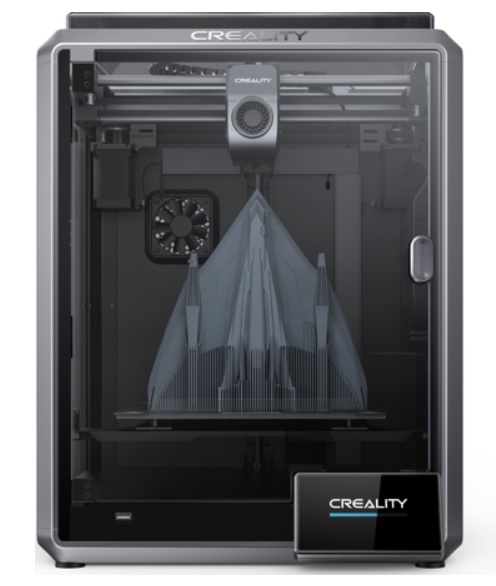Compare Ender 5 vs K1
Comparison between the best 3D printers
Choose the best 3D printer at the best price. The cheapest 3D printers are here.
Buy a 3D printer here with 3D Fila.
 |
 |
|
| Model | Ender 5[BUY Ender 5] |
K1[BUY K1] |
| Printing Material | Filament | Filament |
| Buy Filament for Creality 3D Ender 5 | Buy Filament forCreality 3D K1 | |
| Estimated price | $399,00 | $399,00 |
| Manufacturer | Creality 3D | Creality 3D |
| Release Year | 2020 | 2023 |
| Print Volume [mm] | 220x220x300 | 220x220x250 |
| Printer Size [mm] | 485x510x552 | 355x355x480 |
| Weight [kg] | 11,8 | 12,5 |
| Power Loss Recovery | YES | YES |
| Enclosed printer | NO | YES |
| Bed Leveling | Manual | Automatic |
| Filament End Sensor | NO | YES |
| Bed type | Heated | Heated |
| Power supply system | Bowden | Direct Drive |
| Standard nozzle | 0,4 | 0,4 |
| Maximum Nozzle Temperature [°C] | 255 | 300 |
| Maximum Bed Temperature [°C] | 100 | 120 |
| Maximum printing speed [mm/s] | 180 | 600 |
| Filament holder | YES | YES |
| Camera for supervision | NO | NO |
| Recommended filaments | PLA, TPU, ABS, PETG | ABS, PLA, PETG, PET, TPU, PA, ABS, ASA, PC, PLA-CF, PA-CF, PET-CF |
| Recommended slicers | Cura, Simplify, Slic3r | Creality Print; Cura, Simplify3D e PrusaSlicer |
| Maximum Resolution [mm] | 0,1 | 0,1 |
| Processor | 32 bits | |
| Display | Mono | Display touchscreen 4,3'' |
| Power Supply | 24V / 360W | 110/220V / 350W |
| Connectivity | SD / USB | Ethernet / USB / Wi-Fi |
| Operating systems | Windows, Mac, Linux | Windows, Mac, Linux |
| Date of registration in the system | 2021-04-15 | 2023-04-17 |
| Release date | 2020 | 2023 |
| Extra features | Crealitys Ender 5 stands out with a solid frame and a larger 220 x 220 x 300mm print volume. Its assembly is simple and quick, offering high print quality and speeds of up to 80mm/s. With a magnetic bed, it makes it easy to remove prints. Notable for being hackable and expandable, the Ender 5 continues Crealitys innovative tradition in the affordable 3D printer market. Equipped with a 350W/24V Meanwell power supply, it heats up quickly, in addition to having efficient cable management and modified Marlin firmware. Its unique design includes dedicated stepper motors for each axis and smooth movement on the Y axis, providing more consistent and detailed prints. | The K1 is an extremely fast FDM 3D printer, reaching 600mm/s, 12 times faster than standard models. Equipped with a Core XY system and lightweight print head, it offers energy efficiency and high print quality. It stands out for its dual-gear extruder and quickly heated hotend, as well as dual cooling to prevent warping. Its robust structure ensures stability at high speed, with optimized software to speed up the printing process. |
| Support for multiple colors and materials (AMS and CFS) | NO | NO |
Notes * |
||
| Cost-benefit | 7 / 10 | 8 / 10 |
| Hardware | 1.5 / 10 | 4.8 / 10 |
| Tela | . | . |
| Print volume | 3 / 10 | 3 / 10 |
| Performance | 1 / 10 | 5 / 10 |
| [BUY Ender 5] | [BUY K1] |
Conclusion |
| In comparing the Ender 5 and the K1 3D printers, both from Creality 3D and priced similarly, several key differences emerge that cater to varying user needs and preferences. The Ender 5, launched in 2020, boasts a larger print volume, which is beneficial for users seeking to create bigger projects. It is known for its solid frame and straightforward assembly, making it a great option for beginners and hobbyists. However, it features manual bed leveling and lacks some modern conveniences, such as a filament end sensor or an enclosed build. On the other hand, the K1, released in 2023, represents a significant advancement in speed and automation. Its maximum printing speed of 600 mm/s is exceptionally faster than the Ender 5, which is a clear advantage for users focused on efficiency and higher productivity. Additionally, the K1 includes features such as automatic bed leveling and a direct drive extruder, enhancing print quality and ease of use. However, it has a slightly smaller print volume and is heavier, which may be a consideration for some users. In terms of connectivity, the K1 offers more modern options, including Wi-Fi and Ethernet, providing a more versatile user experience. Conversely, both printers cater well to a range of filaments, but the K1 has slightly broader compatibility, allowing for more material experimentation. Ultimately, if you prioritize speed, ease of use, and modern features, the K1 stands out as the more advanced option and offers better overall performance. However, if you're a beginner looking for a well-established and uncomplicated 3D printing experience at a similar price, the Ender 5 remains a reliable choice. The decision may ultimately come down to individual needs for speed, automation, and print volume. |

